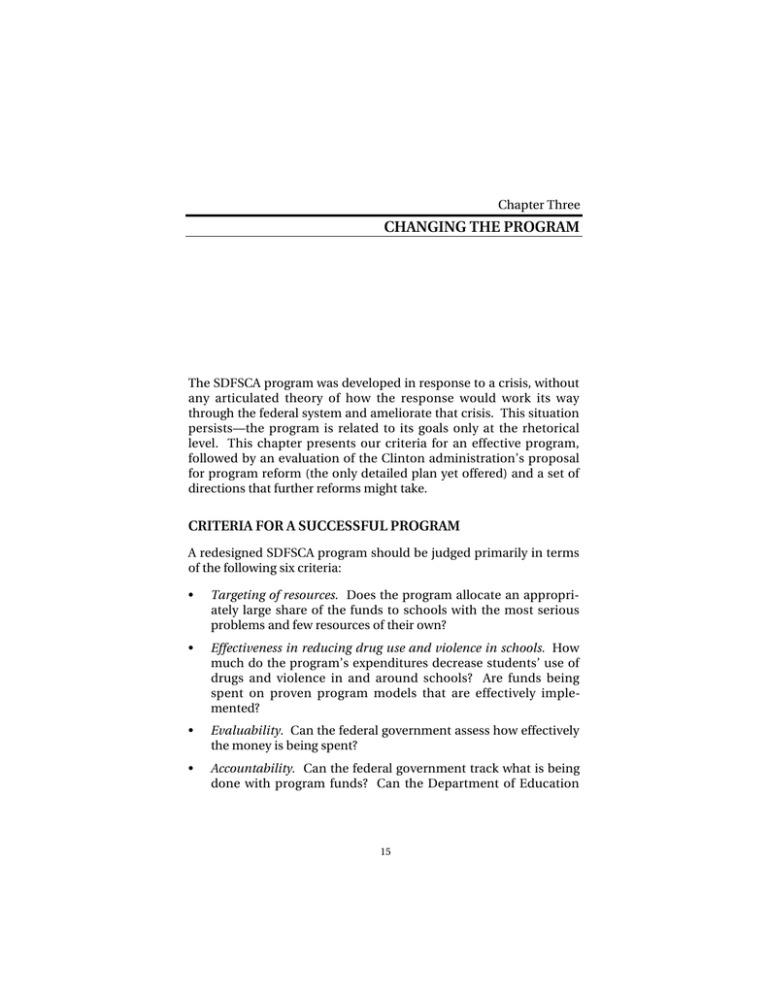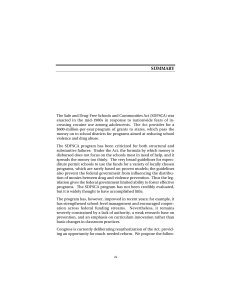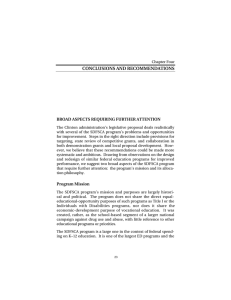CHANGING THE PROGRAM
advertisement

Chapter Three CHANGING THE PROGRAM The SDFSCA program was developed in response to a crisis, without any articulated theory of how the response would work its way through the federal system and ameliorate that crisis. This situation persists—the program is related to its goals only at the rhetorical level. This chapter presents our criteria for an effective program, followed by an evaluation of the Clinton administration’s proposal for program reform (the only detailed plan yet offered) and a set of directions that further reforms might take. CRITERIA FOR A SUCCESSFUL PROGRAM A redesigned SDFSCA program should be judged primarily in terms of the following six criteria: • Targeting of resources. Does the program allocate an appropriately large share of the funds to schools with the most serious problems and few resources of their own? • Effectiveness in reducing drug use and violence in schools. How much do the program’s expenditures decrease students’ use of drugs and violence in and around schools? Are funds being spent on proven program models that are effectively implemented? • Evaluability. Can the federal government assess how effectively the money is being spent? • Accountability. Can the federal government track what is being done with program funds? Can the Department of Education 15 16 Options for Restructuring the SDFSCA determine the extent to which the programs it funds increase school safety and reduce violence and drug use? • Improvement of program capacity. To what extent has the program increased the quality and range of available school interventions? Are new approaches encouraged? Does the program commission or carry out the research, evaluation, and data collection needed to strengthen programs for preventing drug abuse and violence? Does it support appropriate training of teachers and more-active leadership by senior educational officials? • Administrative feasibility and cost. Are the requirements of the program compatible with the managerial and administrative capabilities of schools? How much must be spent by the schools and all levels of government to meet reporting and evaluation requirements? Do administrative costs at all levels of government remain low? THE CLINTON ADMINISTRATION PROPOSAL In August 1999, the Clinton administration announced its proposal for changing the structure of the SDFSCA program (McCaffrey, 1999). The proposal first acknowledges many of the criticisms of the current program, emphasizing that most of the problems cited are structural flaws in the existing legislation rather than implementation failures on the part of the ED. The proposal recommends that districts be required to produce substantive grant proposals and that states develop a formal evaluation process that includes comparisons of those proposals. The criteria to be used for awards include the level of risk of the school district’s population and the district’s fiscal capacity. The language of the proposal suggests that about half of all districts would receive awards. This proposal, which calls for a competitive, targeted allocation process, should ensure that schools use only proven programs and should provide schools with strong incentives to implement these programs effectively. It should also do a better job of directing the funds to those students most in need of prevention programs. Finally, emphasis is given to the need to provide large enough grants to make a difference. With respect to our criteria for a successful pro- Changing the Program 17 gram, this proposal appears to rate highly in terms of accountability, evaluability, and potential program effectiveness. It also moderately improves targeting (see Table 1). Table 1 Evaluation of the Clinton Administration Proposal Criterion Improves effectiveness Better targets resources Improves accountability Promotes evaluability Is administratively feasible, keeps costs low Improves program capacity Rating + ? + + – 0 The proposal clearly does less well in terms of administrative feasibility and cost. State governments will have to develop a proposalevaluation capability, and the school districts will need to have new proposal-writing capabilities. Unless the competition is structured so that only a modest percentage of districts receive funds, the average grant will be too small to justify this process for most districts. At present, the median grant is barely $10,000; even if only one-third of the districts received grants under the proposed competitive process, most grants would still amount to less than $30,000. It would scarcely be worth the effort to prepare competitive proposals for such small grants or to conduct the required evaluations (which would also be a component of the proposed program). One-quarter to one-half of the total funds could be needed to cover administrative costs, including those of evaluation. If, alternatively, states concentrated their program funds among larger school districts with significant problems, evaluation and proposal preparation would require a much smaller share of the awards. However, decisions to concentrate funding at the state level are just as unlikely as are such decisions at the federal level. The Clinton administration’s proposal also places heavy reliance on the fragile research base discussed above. High-quality evaluations are few, and the initial work of the ED’s expert panel to identify proven and promising programs encountered both substantive and procedural problems. The SDFSCA program is, for example, beset with conflict about the evidence in support of DARE, yet it would be 18 Options for Restructuring the SDFSCA politically foolhardy to suggest a program design requiring many, if not most, districts to give up a curricular approach with such strong support from parents and police. Also, as discussed above, it is inherently particularly difficult to evaluate those dispersed features of school management and activity that influence school safety and drug use. It is likely that the programs that are easiest to evaluate will most readily pass muster (Gottfredson, 1997). Finally, the Clinton administration’s proposal does not contain the building blocks for systematic long-term program improvement. Most major federal programs in education and other policy areas supplement their formula grant programs with an array of capacitybuilding activities, e.g., in programmatic research, demonstration, teacher preparation, and evaluation. Until recently, the SDFSCA program has had no such capacity for improvement, and it still has very little. The program provides no money for teacher training or research, nor is such authority included in the Clinton administration’s proposal.1 Little use has been made of the ED’s general authority for research (the Office for Educational Research and Improvement) or for program management and evaluation (the General Education Provisions Act) to improve the SDFSCA program. These authorities reserve no resources for the program, and they make no provisions for coordination among research, training, and operational support for it. DEVISING ALTERNATIVES Given that the Clinton administration’s proposal, while an improvement, is insufficient, what further action might be taken? One option would be to abandon the SDFSCA program in its present form. Should it be limited to violence prevention? That seems more related to schools’ core mission of providing effective education than does drug prevention. But the history of the program, rooted in the crack crisis and sustained by the continuing “War on Drugs,” keeps the focus on drugs. Political gridlock within and among the levels and ______________ 1 The National Institute on Drug Abuse and the Center for Substance Abuse Prevention fund research on drug prevention; the National Institute on Mental Health and the Office for Juvenile Justice and Delinquency Prevention fund research on violence prevention. Changing the Program 19 branches of government may ensure maintenance of the status quo. In this light, given its inattention to coordination and accountability and the lack of evidence of its effectiveness, the SDFSCA program seems fundamentally irremediable. The argument in favor of abandoning the SDFSCA program, however, is based only on the politics of the program’s origin and continuation. The argument may indeed be persuasive, but signs of progress in the program call for serious consideration of its retention. Steps in the right direction include increased collaboration with other federal programs aimed at helping youth with a variety of behavioral problems and a new focus on the middle school. That the political climate may be changing is also suggested by congressional willingness to give a larger share of funds to federally controlled discretionary programs. The SDFSCA program’s long-time, politically driven block-grant character may be gradually superseded by genuine expectations and requirements for targeted, effective action. If continuation is judged desirable, reform should go beyond the steps proposed by the Clinton administration. 2 The criteria listed at the beginning of this chapter suggest three major dimensions of change: the way funds are allocated within states (assuming that interstate allocations are not likely to change3), the means by which the federal government enhances the content of programs, and the methods by which program performance is judged. Funding Formulas There are several ways that allocation protocols could be revised to further the Act’s purposes: • To enhance quality and allow more demonstration programs, more discretion could be shifted to the ED. Although Congress did provide the Department substantially more discretionary ______________ 2 The Bush administration’s proposal for reform of the SDFSCA program suggests performance-based grants, but only in the most general fashion. 3 Congress could attempt to improve targeting across states to take account of differences in state problems and resources, as it does with the Substance Abuse and Mental Health Block Grant. Such formulas require large quantities of data, however, as well as political courage (Burnam et al., 1997). 20 Options for Restructuring the SDFSCA funds in 1999 ($80 million out of $550 million), the program remains primarily formula driven. • A formula could be used that assures that schools serving poor communities and enrolling children at higher victimization risk receive substantially higher per-pupil awards. • A minimum grant size could be established, thus excluding or redirecting some district efforts. • Matching or other requirements for state and local contributions could be implemented. • A competitive grant process within states could be required. These alternatives are not mutually exclusive. For example, a higher share of appropriations could be set aside for federal discretionary grants, with the remaining moneys being used to fund state-run competitive grants in which district or student needs play a role. A requirement for matching funds would expand targeted resources at both the state and the local level. If some small districts no longer qualified for awards because of a grant minimum, they could be encouraged (as they have been by the Federal Vocational Education program since 1994) to form consortia of small districts; such consortia are already permitted and used by some districts (U.S. Department of Education, 1994). Alternatively, small districts that succeed in presenting evidence of proven effectiveness in their use of SDFSCA funds could be exempted from newly established minimums. Determining Content Three general strategies could be used to enhance the content of programs. They are listed here in descending order of coerciveness: • Acceptable approaches could be listed, and funds could be limited to those on the list. • Performance standards could be set, with the means by which these are achieved left to the school districts. Changing the Program • 21 Guidelines could be provided and information disseminated to schools, with the choice of funded activity left entirely to the districts and schools. These options reflect differing views about the relative competence of different levels of government to make these kinds of decisions. The first option, centralizing the listing of acceptable programs, creates a bureaucratic process that may stifle innovation but assures a minimum level of quality. The second option sets performance standards, but such standards are difficult to enforce, given the complexity and expense of outcome measurement. However, if combined with requirements for regular public release of state and local results, performance standards might build popular pressure for improvement. The third option, providing guidelines, is close to the status quo and is perceived to have been generally ineffective, perhaps because the guidelines have seldom been monitored. A basic problem with all of these choices is that each assumes a level of reliable knowledge that is not currently in view. Evaluation Accountability is a concern throughout the federal government. It refers to the ability to show not merely that funds have been properly spent but that they have accomplished worthwhile results. Evaluation can be carried out in a variety of fashions ranging from assessment of the performance of each individual grant (to assure that funds were spent appropriately) to review of the overall national performance of the program. Evaluation also can be used for a number of purposes, including learning what works, rewarding highperforming grantees, and assessing the returns on investment of public moneys. Formal evaluation of individual SDFSCA grants could be particularly challenging. It could, for example, require that schools conduct surveys of alcohol, tobacco, and drug use, as well as develop indicators for the levels of violence in the community. Defining and measuring the many subtle program influences and outcomes would require considerable sophistication and expense.




